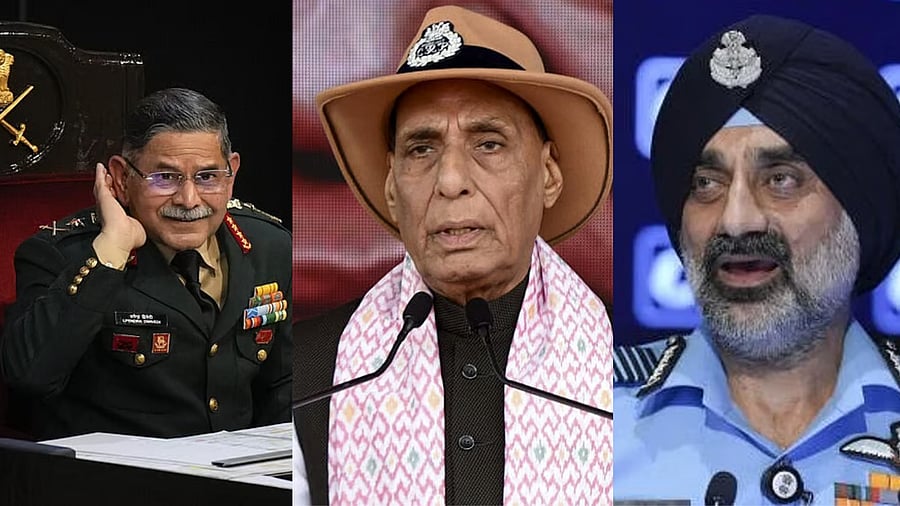
Army Chief Gen Upendra Dwivedi, Defence Minister Rajnath Singh and Air Force Chief Air Chief Marshal A P Singh.
Credit: PTI photos
In a series of stern statements over the past week, India’s top defence leadership, including Defence Minister Rajnath Singh, Army Chief Gen Upendra Dwivedi, and Air Force Chief Air Chief Marshal A P Singh, has sent a unified, uncompromising message to Pakistan, warning of severe consequences in the event of future provocations.
Speaking at Bhuj Military Station in Gujarat on Thursday, Defence Minister Rajnath Singh issued a warning that any misadventure by Pakistan in the Sir Creek sector would invite an Indian response “so strong and decisive that it would change both history and geography.” Referring to the disputed 96-km tidal estuary between the Rann of Kutch and Pakistan, Singh highlighted Islamabad’s recent military infrastructure expansion in the area as evidence of ill intent.
“If Pakistan dares to act in Sir Creek, the reply will be so strong that it will change both history and geography. In 1965, the Indian Army showed courage by reaching Lahore, and in 2025 Pakistan must remember that the road to Karachi also passes through the Creek,” the Defence Minister said.
He underlined India’s past efforts to resolve the boundary dispute through dialogue, noting that Pakistan has ignored such initiatives and instead bolstered its military presence with new battalions, coastal defence boats, and assault craft.
Singh inaugurated the Tidal Independent Berthing Facility and the Joint Control Centre (JCC) at Bhuj, facilities aimed at enhancing joint operational capability, coastal security coordination, and rapid response to threats. During the visit, he performed the traditional Shastra Puja on Vijaya Dashami and spent two days with senior military officials reviewing strategic deployments.
The Army Chief, Gen Upendra Dwivedi, reinforced this message on Friday, warning that India would not show restraint in any future military operation similar to Operation Sindoor, conducted in response to the April 22 Pahalgam terror attack. “India is fully prepared this time. And this time, we will not show the restraint that we showed in Operation Sindoor 1.0. Keep yourselves fully prepared now; if God wants, the opportunity will come soon,” he told troops at Anupgarh in Rajasthan.
Dwivedi also suggested that any continued Pakistani sponsorship of terrorism could jeopardize Pakistan’s “geographical presence,” underscoring the gravity of India’s warning. During a media interaction, he recalled that Operation Sindoor targeted nine specific terrorist infrastructure sites inside Pakistan — seven by the Army and two by the Air Force — without harming ordinary citizens.
In his first post-conflict media interaction, Air Chief Marshal A P Singh detailed the IAF’s achievements during Operation Sindoor, stating that 11–12 Pakistani aircraft, including F-16s and JF-17s, were neutralised. Key targets destroyed included four radar sites, two command and control centres, two runways, three hangars, a large C-130J class aircraft, and one large airborne early warning or signal intelligence aircraft. Singh dismissed Pakistan’s claims of shooting down seven Indian aircraft as “manohar kahaniyan” (fanciful tales), noting that India has not suffered any significant damage to its bases.
Singh also provided a glimpse into India’s future air power, discussing plans for the indigenous Advanced Medium Combat Aircraft (AMCA), scheduled to fly by 2028 with induction by 2035, and the upcoming LCA Mk-2 fighter jets, promising greater weapons capacity and endurance.
Taken together, these statements from India’s defence leadership paint a clear picture: Operation Sindoor was a calibrated response with measured objectives, but India is signalling that future provocations — particularly in Kashmir or strategic areas like Sir Creek — will elicit decisive, no-restraint responses. Analysts suggest this coordinated messaging is aimed at both deterring Pakistan and signalling to the international community India’s operational readiness and strategic resolve.
